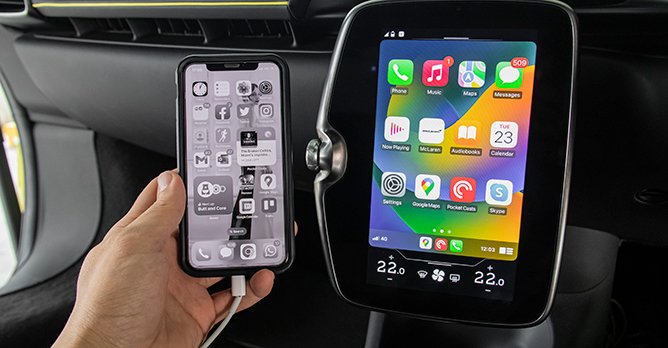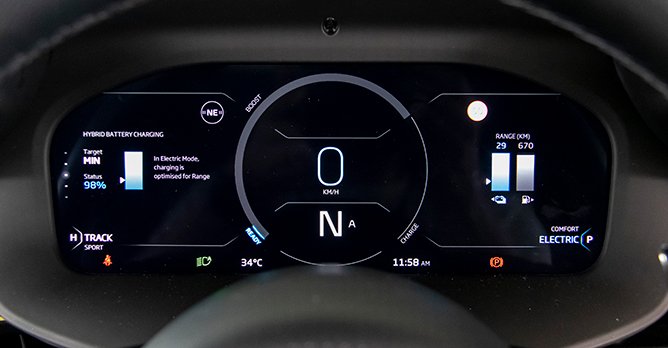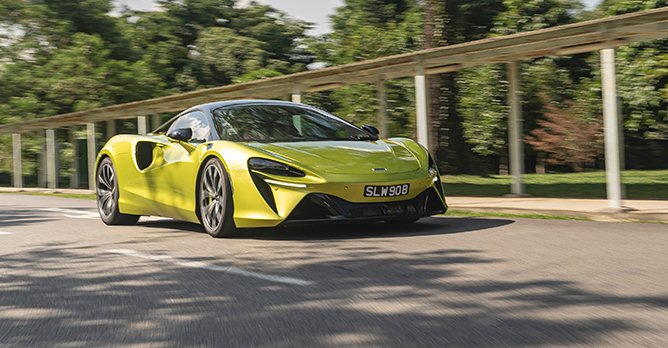McLaren Artura Plug-in Hybrid 3.0 V6 (A) Review
26 May 2023|3,319 views
What We Like
Familiar McLaren design made tighter and sleeker
Clean and minimalist cabin with a good amount of features
Ample performance, with no turbo lag thanks to the help of electric power
Can be charged and driven quietly
Electrification is a plus all around
Packs all the supercar flair and dazzle that you want
What We Dislike
$1.3 million price tag, and you're going to have to wait to get yours
Comes with the usual supercar inconveniences
I generally don't fully enjoy driving supercars in Singapore. It's not because these cars aren't exciting or fun to drive (they almost always are). It's because supercars, by their nature, are designed to go really quickly around a race track. Powerful, low slung, unencumbered by daily amenities, these things come to define supercars. They aren't primarily designed to live in dense city centres.
Which of course means that there are plenty of compromises that come with driving a supercar in Singapore. Getting in and out is never elegant. There's much more power than you can reasonably (legally) use, and you'll never even scratch the surface of the car's dynamic capabilities.
And then, there's the perception of it all.
Being a 33-year old Chinese male driving a supercar invites a mix of approving glances and judgemental stares, not helped by the ruckus that's made every time you pull up to a location.
Of course, you also have to carefully consider where you go and parking spaces. Steep ramps? No go. Lots of humps? No go. Tight lots? No go. You might even manage to fit into a lot before realising there's not enough space to open those damn scissor doors.
Couple that with the constant stress of thinking, "Now now, be careful, don't scratch this million dollar car that you DO NOT OWN", and you can see why driving a supercar is much more stressful than I'd like my typical daily commute to be.
So, that brings me to the brand new McLaren Artura. In many ways, this is the next-generation supercar, but does it resolve some of these traditional supercar compromises?
What we already know

This is the McLaren Artura, the marque's brand new plug-in hybrid sports car that heralds in the future of high-performance motoring.
Not that you can necessarily tell just by looking at it. It sports a familiar cab-forward McLaren silhouette, and to untrained eyes probably does not set itself apart that significantly from the models that came before.
I happen to think this is one of the better-looking McLarens. The shapes are simpler, the overall visual language more compact and tighter, and there's a touch less flamboyance to the way it carries itself visually compared to something like a 720S (though some may argue flamboyance is entirely the point of such cars).
The flairs not gone, obviously, as evidenced by the scissor doors. Though, I will note that the doors don't open as far outwards as you may fear, so there's less worry that you may not be able to get out of the car when parked next to another vehicle.
Step inside the Artura and you are greeted by a fairly familiar and minimalist interior, though there's clearly been an effort made to simplify and further streamline the cabin. For example, the controls for adjusting the Handling and Powertrain settings are now mounted atop the dash, providing easy control while your hands are on the wheel.
Infotainment functionality is now found within a floating screen, where you'll find perhaps more features than you'd expect - wired Apple CarPlay, in-built navigation, even ambient lighting. Thus, the centre console has been simplified so much that just four buttons remain - Engine Start/Stop, D, N, R, and the hazard light switch.
Combine this with the pretty generous greenhouse all around and what you get is a space that feels airy (by supercar standards). Build quality is not best-in-class, and the rear-view camera displayed in the dashboard will get obscured when turning the wheel while reversing, but all in all there's plenty to enjoy about this cabin.
But the biggest surprise is when you depress the brake and hit the red engine start button.
A quiet step into the unknown
That's because besides some graphics changing, it would appear that nothing has happened. You don't get the expected burble of a supercar kicking into life.
That, is sort of the point. The Artura has a plug-in hybrid powertrain - a 3.0-litre twin-turbo V6 paired with an electric motor that's powered by a 7.4kWh battery. Left to its own devices (and with sufficient charge), the car wants to start in all electric mode.
I guarantee you, casual onlookers will be shocked when they see this Artura trundling along through the carpark in silence. And you can keep going in electric-only mode for up to about 30km on a full charge (and can plug in to go further still). Driven such, it's not quick (no quicker than a Kia Niro Electric in my estimation), but its brisk enough and will still get you places.
But this is no electric super car. The electrification is really designed to serve performance (braking is purely mechanical, there's no regenerative braking thus ensuring natural brake feel). Combined, the system can produce a whopping 671bhp and 720Nm of torque, pushing the car to 100km/h from standstill in just 3.0 seconds. And yes, it's every bit as quick as that timing would suggest.
More importantly, the electric motor helps to fill in gaps in the combustion engine's torque curve, so there's really no sign of turbo lag. This means that power is always readily available, and does make driving at lower revs more tractable.
To be fair, it's not like you can use much of that power on local roads. A quick blast in second gear would already put you over the speed limit. And handling? I wish I could tell you about how it handles, but that's really something that can only be properly explored on a race track (you can read Julian's impressions here).
What I can tell you is that it feels quite forgiving and usable. The hydraulic steering is sharp, responsive and accurate, the chassis very composed, and the overall ride pretty pliable in the Comfort setting. Track is unusable unless you want to be permanently jiggled about, but even Sport is possible if you prefer a firmer overall ride.
The V6 makes a good sound when you push it, too. The overall driving experience is perhaps not the most emotional, but there's no denying the effectiveness of the way the Artura is able to tackle tarmac.
The next generation

Electrified drivetrains are what will allow supercars to continue to exist in the near future. And it's not just this Artura - we've already seen other supercar makers bring out PHEV models of their own.
But its clear that while the plug-in hybrid drivetrain helps fulfil emissions regulations, the functionality really is serving performance - to allow as much (or even more) power with smaller capacity engines. And here, the integration of the plug-in hybrid drivetrain in this Artura is seamless. You don't feel it as much as you hear it.
But what the Artura also proves is that electrification can also make the everyday supercar experience better. You can return home past midnight and not annoy the whole estate. And when you're not at a race track, you can burn just a tiny bit less fossil fuel, thus staving of impending doom by just a little bit.

Like the McLarens that have come before, the Artura delivers the performance and visual drama that you expect of it. Electrification in this case is an effective addition, without compromising any of the car's performance utility.
Look, the daily compromises have not just magically disappeared with this Artura. It's still an attention-grabbing supercar that you need to get out off slightly un-majestically, and the concerns about tight spaces and problematic parking don't change (though the 360-degree camera helps greatly). But, at least with this Artura, I know that there is at least some option for being slightly less conspicuous.
This is very much the next-generation supercar, a recipe for future McLarens to follow. The fact that the Artura packs all the performance you want and expect, and is also even able to take some strides in improving everyday usability? I don't know about you, but that's a big win to me. And most importantly, the supercar lives.
Catch more of the amazing design and see the plug-in hybrid drivetrain of this McLaren Artura in action here!
What We Like
Familiar McLaren design made tighter and sleeker
Clean and minimalist cabin with a good amount of features
Ample performance, with no turbo lag thanks to the help of electric power
Can be charged and driven quietly
Electrification is a plus all around
Packs all the supercar flair and dazzle that you want
What We Dislike
$1.3 million price tag, and you're going to have to wait to get yours
Comes with the usual supercar inconveniences
I generally don't fully enjoy driving supercars in Singapore. It's not because these cars aren't exciting or fun to drive (they almost always are). It's because supercars, by their nature, are designed to go really quickly around a race track. Powerful, low slung, unencumbered by daily amenities, these things come to define supercars. They aren't primarily designed to live in dense city centres.
Which of course means that there are plenty of compromises that come with driving a supercar in Singapore. Getting in and out is never elegant. There's much more power than you can reasonably (legally) use, and you'll never even scratch the surface of the car's dynamic capabilities.
And then, there's the perception of it all.
Being a 33-year old Chinese male driving a supercar invites a mix of approving glances and judgemental stares, not helped by the ruckus that's made every time you pull up to a location.
Of course, you also have to carefully consider where you go and parking spaces. Steep ramps? No go. Lots of humps? No go. Tight lots? No go. You might even manage to fit into a lot before realising there's not enough space to open those damn scissor doors.
Couple that with the constant stress of thinking, "Now now, be careful, don't scratch this million dollar car that you DO NOT OWN", and you can see why driving a supercar is much more stressful than I'd like my typical daily commute to be.
So, that brings me to the brand new McLaren Artura. In many ways, this is the next-generation supercar, but does it resolve some of these traditional supercar compromises?
What we already know

This is the McLaren Artura, the marque's brand new plug-in hybrid sports car that heralds in the future of high-performance motoring.
Not that you can necessarily tell just by looking at it. It sports a familiar cab-forward McLaren silhouette, and to untrained eyes probably does not set itself apart that significantly from the models that came before.
I happen to think this is one of the better-looking McLarens. The shapes are simpler, the overall visual language more compact and tighter, and there's a touch less flamboyance to the way it carries itself visually compared to something like a 720S (though some may argue flamboyance is entirely the point of such cars).
The flairs not gone, obviously, as evidenced by the scissor doors. Though, I will note that the doors don't open as far outwards as you may fear, so there's less worry that you may not be able to get out of the car when parked next to another vehicle.
Step inside the Artura and you are greeted by a fairly familiar and minimalist interior, though there's clearly been an effort made to simplify and further streamline the cabin. For example, the controls for adjusting the Handling and Powertrain settings are now mounted atop the dash, providing easy control while your hands are on the wheel.
Infotainment functionality is now found within a floating screen, where you'll find perhaps more features than you'd expect - wired Apple CarPlay, in-built navigation, even ambient lighting. Thus, the centre console has been simplified so much that just four buttons remain - Engine Start/Stop, D, N, R, and the hazard light switch.
Combine this with the pretty generous greenhouse all around and what you get is a space that feels airy (by supercar standards). Build quality is not best-in-class, and the rear-view camera displayed in the dashboard will get obscured when turning the wheel while reversing, but all in all there's plenty to enjoy about this cabin.
But the biggest surprise is when you depress the brake and hit the red engine start button.
A quiet step into the unknown
That's because besides some graphics changing, it would appear that nothing has happened. You don't get the expected burble of a supercar kicking into life.
That, is sort of the point. The Artura has a plug-in hybrid powertrain - a 3.0-litre twin-turbo V6 paired with an electric motor that's powered by a 7.4kWh battery. Left to its own devices (and with sufficient charge), the car wants to start in all electric mode.
I guarantee you, casual onlookers will be shocked when they see this Artura trundling along through the carpark in silence. And you can keep going in electric-only mode for up to about 30km on a full charge (and can plug in to go further still). Driven such, it's not quick (no quicker than a Kia Niro Electric in my estimation), but its brisk enough and will still get you places.
But this is no electric super car. The electrification is really designed to serve performance (braking is purely mechanical, there's no regenerative braking thus ensuring natural brake feel). Combined, the system can produce a whopping 671bhp and 720Nm of torque, pushing the car to 100km/h from standstill in just 3.0 seconds. And yes, it's every bit as quick as that timing would suggest.
More importantly, the electric motor helps to fill in gaps in the combustion engine's torque curve, so there's really no sign of turbo lag. This means that power is always readily available, and does make driving at lower revs more tractable.
To be fair, it's not like you can use much of that power on local roads. A quick blast in second gear would already put you over the speed limit. And handling? I wish I could tell you about how it handles, but that's really something that can only be properly explored on a race track (you can read Julian's impressions here).
What I can tell you is that it feels quite forgiving and usable. The hydraulic steering is sharp, responsive and accurate, the chassis very composed, and the overall ride pretty pliable in the Comfort setting. Track is unusable unless you want to be permanently jiggled about, but even Sport is possible if you prefer a firmer overall ride.
The V6 makes a good sound when you push it, too. The overall driving experience is perhaps not the most emotional, but there's no denying the effectiveness of the way the Artura is able to tackle tarmac.
The next generation

Electrified drivetrains are what will allow supercars to continue to exist in the near future. And it's not just this Artura - we've already seen other supercar makers bring out PHEV models of their own.
But its clear that while the plug-in hybrid drivetrain helps fulfil emissions regulations, the functionality really is serving performance - to allow as much (or even more) power with smaller capacity engines. And here, the integration of the plug-in hybrid drivetrain in this Artura is seamless. You don't feel it as much as you hear it.
But what the Artura also proves is that electrification can also make the everyday supercar experience better. You can return home past midnight and not annoy the whole estate. And when you're not at a race track, you can burn just a tiny bit less fossil fuel, thus staving of impending doom by just a little bit.

Like the McLarens that have come before, the Artura delivers the performance and visual drama that you expect of it. Electrification in this case is an effective addition, without compromising any of the car's performance utility.
Look, the daily compromises have not just magically disappeared with this Artura. It's still an attention-grabbing supercar that you need to get out off slightly un-majestically, and the concerns about tight spaces and problematic parking don't change (though the 360-degree camera helps greatly). But, at least with this Artura, I know that there is at least some option for being slightly less conspicuous.
This is very much the next-generation supercar, a recipe for future McLarens to follow. The fact that the Artura packs all the performance you want and expect, and is also even able to take some strides in improving everyday usability? I don't know about you, but that's a big win to me. And most importantly, the supercar lives.
Catch more of the amazing design and see the plug-in hybrid drivetrain of this McLaren Artura in action here!
Car Information
McLaren Artura Plug-in Hybrid 3.0 V6 (A)
POA
CAT B|Petrol-Electric|20.8km/L
Horsepower
515kW (691 bhp)
Torque
720 Nm
Acceleration
3sec (0-100km /hr)
Thank You For Your Subscription.












































































